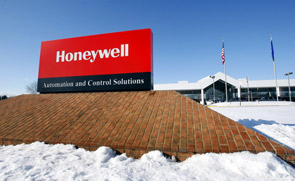Honeywell Inc: The Making of a Global Company
How Honeywell Transformed From Start-up To Multi Billion Dollar Company
The beginning may be humble, but with innovative product that meets the need of many, a business can grow out of the backyard into many nations of the world. Such is the amazing story of Honeywell Inc.
Honeywell’s beginning can be traced back to 1885 when Albert Butz invented and patented furnace regulator and alarm, and in 1886 again invented an innovative device, a thermostat, which he named “damper flapperâ€. This simple tool automatically controls the temperature of a room by allowing air into the furnace to heat it up and increase the temperature of the room when the temperature drops below a preset low point, and to close the furnace when the temperature reaches a preset high point. With this thermostat, one could keep their home automatically at conducive temperature all the time.
Butz’s patent and business was acquired by the Consolidated Temperature Controlling Co. Incorporated, which became the Electric Heat Regulator Co. in 1893. The company was purchased in 1898 by W.R Sweatt, and by 1916 it was renamed Minneapolis Heat Regulator Company.
Meanwhile, in 1906, a young engineer by name Mark Honeywell had formed Honeywell Heating Specialty Co. Incorporated, a plumbing and heating business, which specialized in hot water heat generators.
1927 came the merger of the two companies, Minneapolis Heat Regulator Company and Honeywell Heating Specialty Co. to form the Minneapolis-Honeywell Regulator Co. The new company with W. R. Sweatt as Chairman and Mark Honeywell as President, immediately became the largest producer of high-quality jeweled clocks.
The company sought to dominate its market by acquisition. It bought several companies, including Brown Instrument Co., a global leader in industrial controls and indicators. Though the company had been selling around the world through distributors like Yamatake Trading Company, Japan, for many years, it officially began international expansion in 1934 with the acquisition of Time-O-Stat Controls Corporation and the establishment of the first office outside the U.S. in Toronto, Canada. Still in that year, the company established its first European subsidiary in the Netherlands.
A few years later, it had offices in London and Stockholm. By 1972 there were distributors for the company’s products in Chile, Panama, Trinidad, New Zealand, Argentina, and South Africa. The company continued to expand across the world, and by 1998 its operations had reached 95 countries of the world.
Minneapolis-Honeywell Regulator Co. backed on its massive scientific and engineering talents to create and extend its product line to include arrays of aeronautical equipment, while also quickly adapting to change.
In 1953, it launched the T-86 “Round†thermostat, which was an improvement over the chunky rectangular model, and it became an instant hit. Still in production up till date, it is the most popular thermostat in homes worldwide among its competitors.
In 1957, Minneapolis-Honeywell Regulator Co. started building its security business with the purchase of a fire detection and alarm firm. Today, the company is easily recognized as a world leader in security systems. Minneapolis-Honeywell Regulator Co. became officially known as Honeywell Inc. in 1963 and in 1969 Honeywell again proved to be reliable and dependable as its instruments helped U.S. astronauts, Neil Armstrong and Edwin Aldrin land on the moon.
In 1991, Honeywell sold off its computer business, which it entered in 1955, when it was no longer profitable with the coming of personal computers in the 1980s, to concentrate on applying its digital computer knowledge on thermostat systems, aerospace, defense equipment, automation control, integrating sensors, and activators, which were its original area of expertise. The company continued to be a world leader in heating controls and alarm systems.
With the purchase of Sperry Aerospace in 1986 for $1 billion, Honeywell established itself the world’s leading integrator of avionics systems. Sperry brought flight controls, space vehicles, and the first FAA-certified wind shear warning system to Honeywell business, with Honeywell’s sales increasing by 21 percent yearly.
In 1999, Honeywell merged with AlliedSignal, Inc. (while retaining the Honeywell name), to form what was described as “aerospace powerhouse.” AlliedSignal brought its expertise in the manufacturing of aircraft equipment such as engines, brakes, flight data recorders, warning systems, collision-avoidance systems, and cockpit voice recorders to Honeywell’s strength in aircraft control system. This marriage increased the company’s aerospace business.
Honeywell adopted AlliedSignal’s operational cost saving strategy called Six Sigma, which it renamed Six Sigma Plus. The strategy helped the company to operate more effectively and efficiently in all its departments at lower cost. By 1999 the Six Sigma operational system had saved the company $2.2 billion.
Today, with product line covering turboprop engines, flight safety and landing systems, automation and controls, heating, ventilation, materials used in semiconductors, polymers for electronics, fibers, friction materials, and consumer car products, meeting the needs of millions of people in more than 95 countries, including Asian Pacific, Europe, Middle East, Africa, and Latin American regions; and with over 43,000 employees worldwide, Honeywell has grown exceedingly from a local start-up to a multinational company of immense success.
Read Honeywell Business Strategies here
………………………………..
Recommended
Put your business on the path to success with a solid plan created with Business Plan Pro Software .
Experts in business and technology, as well as daily users rate this software higher and above others. Click here to see why

Thank you for sharing this interesting story. Heart, determination, and perseverance are keys to success.
Very interesting history, but do you know what success principles they were using? No doubt, they followed God’s success principles.